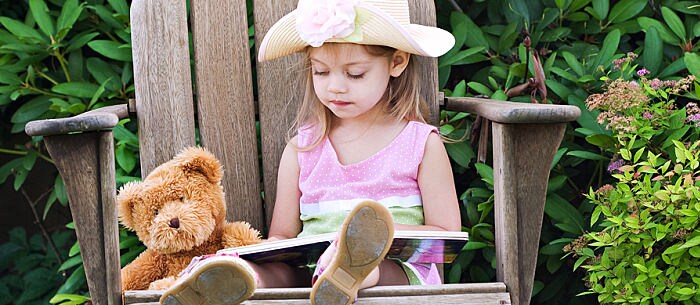Even when they are only toddlers, you can help your children develop a whole host of skills which will enormously help them learn to read. The first four skills a child needs for learning to read include:
- understanding the concept of print,
- building language and listening skills,
- knowing the letters of the alphabet,
- and developing phonemic awareness: the ability to think about, analyse and manipulate the structure of individual words.
You know your child is ready to learn to read as soon as they have mastered the alphabet, started to recognise letters and words on signs, or if they’ve started holding the book upright and pretend to track print.
Once you’ve seen these signs that they’re interested, it’s all ‘go, go, go!’. With these simple tips, you can keep their interest and build upon the 4 aforementioned skills until you have a little bookworm on your hands.
Read Together
It sounds obvious, but practice really does make perfect. By reading books to your child daily, you’re not only setting them up to learn to read, but you’re also fostering a passion and enjoyment for it. Even if you only manage a book or two at bedtime, it’s important to incorporate reading into your daily routine from a very early age — get them excited about story time. How often you read to a child has an enormous influence on their reading success.
Reading to your child regularly teaches them the basic concepts of books — that print represents spoken words, for example. As you read, ask your child open-ended questions about the story. This helps develop listening skills and gives your child an opportunity to talk about words they may not understand.
Memorise Sight Words
Once children have begun to develop phonemic awareness (around 3 years old), you can begin focusing on sight words: frequently used, non-phonetic words that should be memorised to help a child learn to read faster. Knowing common words by sight makes reading easier and faster, because the reader does not need to stop to try to sound out each individual word, letter by letter.
Playing word games is an easy and fun way to teach children sight words. Write sight words on post-it notes and hide them around the house for your child to find. You don’t have to plan lots of daily activities — instead, look for opportunities to fit games into your daily routine. Use the world as your classroom, and have your child do a scavenger hunt for simple words on signs in shops and outside, for example.
Identify Word Families
Groups of words that have a common pattern — like words that contain the ‘at’ sound (cat, hat, sat) — are called word families. Learning groups of similar words can make it easier to recognise and sound out new words as you help your little one learn to read. Much like with sight words, playing games and engaging in hands-on activities can make the learning process much more interesting for toddlers, and preschoolers. Play this fun tossing game to reinforce word family learning: Write sets of rhyming words on heavy-duty paper plates, with one word on each plate (cat, hat, sat, bake, take, lake). Lay hula hoops on the ground and assign each one a suffix (-at, -ake) and have your children toss each plate into the correct hoop. As your children gain a better grasp of this concept, gradually increase the difficulty of the words.
The key to developing successful skills is making reading an enjoyable activity that your child actually looks forward to. Above all, keep practice sessions short and use hands-on materials, not worksheets. If your child resists sitting down, incorporate learning into active games. With younger children especially, it’s important to take it slow and keep learning to read light and fun.
Visit Care.com to browse a range of tutors offering help and support to develop your child’s reading ability.
